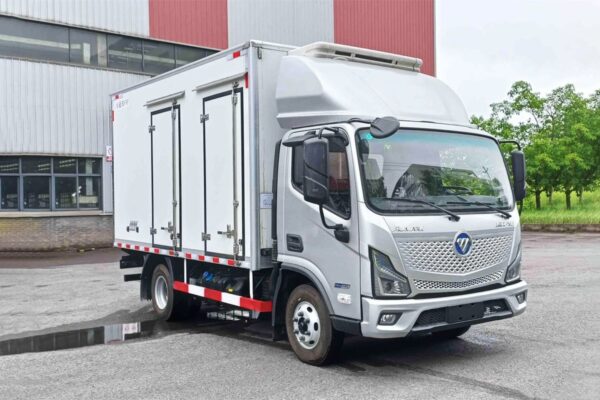Electric Truck Knowledge
Development of Electric Vehicle Off-line Testing Equipment Based on MFC
Preface
Since the invention of the first automobile by German engineer Carl Benz in 1886, the automotive industry has undergone over a century of continuous development. Automobiles have greatly contributed to modern civilization, providing convenience and economic growth. However, they have also played a significant role in environmental degradation, particularly through air pollution.
From the late 20th century onwards, with increasing concerns about environmental protection and energy sustainability, attention has shifted toward mitigating pollution caused by automobile emissions. Traditional internal combustion engine (ICE) vehicles, which rely on petroleum and other fossil fuels, are facing a turning point in their development. Currently, there are approximately 1 billion vehicles worldwide, and this number is expected to triple by 2050. Given the present rate of consumption, global petroleum reserves are estimated to last only another 40 years. This situation highlights the urgent need for the research and promotion of new energy electric vehicles (EVs).
New energy vehicles (NEVs) refer to automobiles that rely partially or entirely on electrical energy to drive their motors. NEVs primarily fall into three categories: Battery Electric Vehicles (BEVs), Hybrid Electric Vehicles (HEVs), and Fuel Cell Electric Vehicles (FCEVs). The future direction of NEVs is expected to be fully electric BEVs. Compared to conventional ICE vehicles, electric vehicles are equipped with advanced Electronic Control Units (ECUs) responsible for vehicle operation and safety. Key control units include the Motor Control Unit (MCU), Battery Management System (BMS), and Vehicle Control Unit (VCU). The reliability of these ECUs directly impacts passenger safety, making it crucial to conduct rigorous inspections of all electrical components, wiring harnesses, and control modules before vehicles leave the factory.
This study focuses on the development of an EV off-line testing system based on MFC (Microsoft Foundation Classes) to meet the requirements of modern EV production lines.

1. Development Status of Off-line Vehicle Testing
1.1 Domestic Development Status
China’s automotive industry is experiencing rapid growth, with increasing vehicle models, production volume, and improved quality standards. From traditional automotive electronic control systems (such as fuel injection systems, airbags, and anti-lock braking systems) to EV power systems, the integration of electronic devices has become more prevalent. Consequently, off-line vehicle testing technology has also evolved significantly. Modern electronic circuits have become highly miniaturized and complex, making testing increasingly challenging. Currently, several methods are employed for circuit inspection:
- Manual Visual Inspection In the early stages of automotive development, inspections were primarily performed manually using visual, auditory, and tactile methods. However, as surface-mounted components became more complex, manual inspection proved unreliable and inefficient. The advent of micro ball grid array (BGA) packages and flip-chip technology made manual visual inspection impractical. Advances in computer technology have led to significant improvements in automated testing techniques, enabling more precise and efficient vehicle diagnostics.
- Optical Inspection Technologies Automated Optical Inspection (AOI) and Automated X-ray Inspection (AXI) systems have been developed to complement manual inspection. While these technologies assist in identifying defects that are difficult to detect visually, their accuracy remains highly dependent on image processing algorithms, which may lead to false positives or negatives.
- Functional Testing Functional testing is crucial in verifying the performance of surface-mounted devices and miniaturized circuit boards. The standardization of testing equipment and virtual instrumentation software has enhanced the universality and flexibility of functional testing, reducing costs and improving efficiency.
1.2 International Development Status
Automotive testing technologies have developed extensively in industrialized nations. The 1950s marked the beginning of structured automotive diagnostic methodologies, and by the late 1960s, advancements in physics, electronics, and optics facilitated more sophisticated diagnostic techniques. The invention of microprocessors in the 1970s laid the foundation for VCU-based diagnostics. Automated vehicle testing equipment soon emerged, integrating data acquisition, processing, and result reporting capabilities.
During the 1980s, automotive diagnostics saw further progress with the introduction of software-integrated diagnostic systems, enabling comprehensive and automated vehicle inspection. These advancements eliminated human error, significantly improving accuracy and efficiency. By the 1990s, on-board diagnostic (OBD) systems became standard, allowing vehicles to report their operational status and detect faults autonomously. The 2000s witnessed the expansion of diagnostic capabilities, including predictive maintenance and failure analysis, enhancing vehicle safety and reliability.
Developed countries have largely institutionalized automotive testing, achieving standardized foundational technologies. The ongoing trend in vehicle diagnostics is toward greater intelligence and automation. Future developments will focus on predictive maintenance systems to enhance diagnostic accuracy and reliability.

2. System Principle Analysis and Overall Design
2.1 Testing Principles
The EV off-line testing system simulates VCU signals via an upper computer, analyzes and deciphers CAN bus messages, identifies faults, and connects to the vehicle’s OBD port to establish a closed-loop diagnostic circuit. The test results are then stored and transmitted to the off-line testing system for further processing.
2.2 CAN Bus Reception and Control
The CAN bus transmits signals using short-frame structures, with each frame containing 8 bytes of data. This ensures high-speed transmission and strong anti-interference capabilities. The system can automatically disconnect faulty nodes to prevent network-wide disruption. By leveraging bus arbitration technology, lower-priority nodes defer to higher-priority nodes, avoiding bus conflicts. The CAN bus receives various signals, including status indicators, engine data, and diagnostic messages, which are used to develop monitoring programs.
2.3 Hardware Connection
The testing system connects to the vehicle’s CAN bus to process high-speed and low-speed data. The OBD interface is defined as follows:
- CAN A: Pin 6 (CAN High) and Pin 14 (CAN Low)
- CAN B: Pin 11 and Pin 12
A diagnostic cable with an OBD connector on one end and dual DB9 connectors on the other facilitates connection between the vehicle and an industrial PC (IPC). The IPC includes a CAN card for data transmission and reception, enabling comprehensive vehicle diagnostics.
2.4 Test Equipment Setup and Overall Process
The off-line testing equipment is installed at the end of the production line, allowing for seamless and efficient testing. The testing process includes the following steps:
- Connecting the diagnostic cable between the testing device and the vehicle’s OBD port.
- Powering on the system and launching the diagnostic software.
- Establishing communication between the CAN interface and the vehicle network.
- Conducting automated diagnostics and displaying results in real-time.
- Printing the test results upon completion.
- Repeating the process for subsequent vehicles.
The software is divided into three modules:
- Basic Information Entry – Records vehicle details via barcode scanning.
- Data Display – Shows diagnostic results with visual indicators for fault status.
- Report Printing – Generates a summary of the test results.
3. Software Design
The testing software operates on an industrial PC and interfaces with the vehicle via CAN communication. It adheres to the Unified Diagnostic Services (UDS) protocol (ISO 14229), which standardizes the exchange of diagnostic messages between the vehicle and external testing equipment.
3.1 UDS Communication Mechanism
The UDS protocol defines a set of diagnostic services, including communication management, data transfer, input/output control, and remote activation routines.
3.2 Software Testing Modules
- Fault Code Reading and Clearing
- Clears stored Diagnostic Trouble Codes (DTCs).
- Retrieves and displays fault codes for analysis.
- Actuator Testing
- Requires security verification.
- Temporarily controls actuators for functional assessment.
- VCU Data Retrieval
- Reads hardware/software versions, manufacturing dates, and PCB identifiers.
- Data Writing
- Stores VIN and installation date in the VCU’s EEPROM.

Conclusion
The developed system successfully integrates fault code diagnostics, actuator testing, VCU data retrieval, and parameter writing, significantly improving testing efficiency and ensuring EV production quality.
